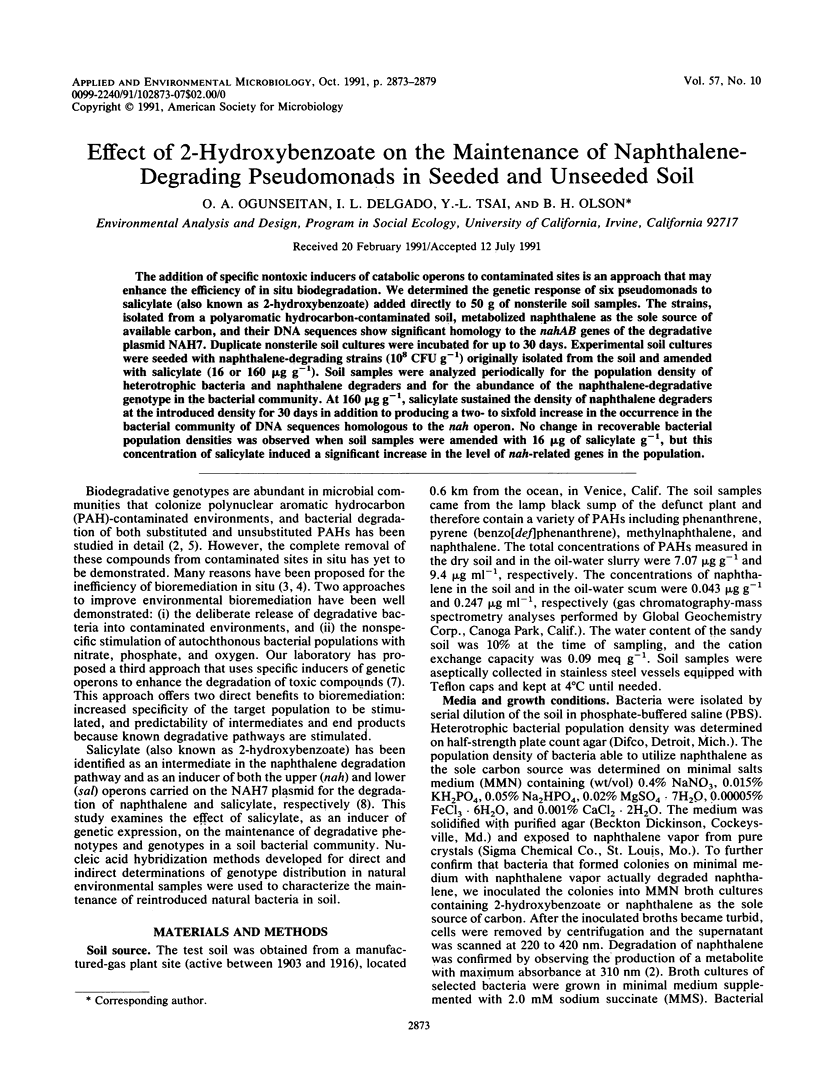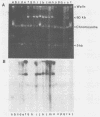Abstract
The addition of specific nontoxic inducers of catabolic operons to contaminated sites is an approach that may enhance the efficiency of in situ biodegradation. We determined the genetic response of six pseudomonads to salicylate (also known as 2-hydroxybenzoate) added directly to 50 g of nonsterile soil samples. The strains, isolated from a polyaromatic hydrocarbon-contaminated soil, metabolized naphthalene as the sole source of available carbon, and their DNA sequences show significant homology to the nahAB genes of the degradative plasmid NAH7. Duplicate nonsterile soil cultures were incubated for up to 30 days. Experimental soil cultures were seeded with naphthalene-degrading strains (10(8) CFU g-1) originally isolated from the soil and amended with salicylate (16 or 160 micrograms g-1). Soil samples were analyzed periodically for the population density of heterotrophic bacteria and naphthalene degraders and for the abundance of the naphthalene-degradative genotype in the bacterial community. At 160 micrograms g-1, salicylate sustained the density of naphthalene degraders at the introduced density for 30 days in addition to producing a two- to sixfold increase in the occurrence in the bacterial community of DNA sequences homologous to the nah operon. No change in recoverable bacterial population densities was observed when soil samples were amended with 16 micrograms of salicylate g-1, but this concentration of salicylate induced a significant increase in the level of nah-related genes in the population.
Full text
PDF






Images in this article
Selected References
These references are in PubMed. This may not be the complete list of references from this article.
- Anderson D. G., McKay L. L. Simple and rapid method for isolating large plasmid DNA from lactic streptococci. Appl Environ Microbiol. 1983 Sep;46(3):549–552. doi: 10.1128/aem.46.3.549-552.1983. [DOI] [PMC free article] [PubMed] [Google Scholar]
- Cerniglia C. E. Microbial metabolism of polycyclic aromatic hydrocarbons. Adv Appl Microbiol. 1984;30:31–71. doi: 10.1016/s0065-2164(08)70052-2. [DOI] [PubMed] [Google Scholar]
- Goldstein R. M., Mallory L. M., Alexander M. Reasons for possible failure of inoculation to enhance biodegradation. Appl Environ Microbiol. 1985 Oct;50(4):977–983. doi: 10.1128/aem.50.4.977-983.1985. [DOI] [PMC free article] [PubMed] [Google Scholar]
- Jain R. K., Sayler G. S. Problems and potential for in situ treatment of environmental pollutants by engineered microorganisms. Microbiol Sci. 1987 Feb;4(2):59–63. [PubMed] [Google Scholar]
- Mueller J. G., Chapman P. J., Pritchard P. H. Action of a fluoranthene-utilizing bacterial community on polycyclic aromatic hydrocarbon components of creosote. Appl Environ Microbiol. 1989 Dec;55(12):3085–3090. doi: 10.1128/aem.55.12.3085-3090.1989. [DOI] [PMC free article] [PubMed] [Google Scholar]
- Schell M. A. Transcriptional control of the nah and sal hydrocarbon-degradation operons by the nahR gene product. Gene. 1985;36(3):301–309. doi: 10.1016/0378-1119(85)90185-4. [DOI] [PubMed] [Google Scholar]
- Torsvik V., Salte K., Sørheim R., Goksøyr J. Comparison of phenotypic diversity and DNA heterogeneity in a population of soil bacteria. Appl Environ Microbiol. 1990 Mar;56(3):776–781. doi: 10.1128/aem.56.3.776-781.1990. [DOI] [PMC free article] [PubMed] [Google Scholar]
- Tsai Y. L., Olson B. H. Rapid method for direct extraction of DNA from soil and sediments. Appl Environ Microbiol. 1991 Apr;57(4):1070–1074. doi: 10.1128/aem.57.4.1070-1074.1991. [DOI] [PMC free article] [PubMed] [Google Scholar]
- Tsai Y. L., Park M. J., Olson B. H. Rapid method for direct extraction of mRNA from seeded soils. Appl Environ Microbiol. 1991 Mar;57(3):765–768. doi: 10.1128/aem.57.3.765-768.1991. [DOI] [PMC free article] [PubMed] [Google Scholar]




